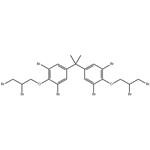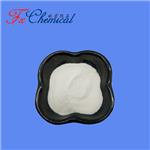Tetrabromobisphenol A Bis(dibromopropyl Ether): Flame Retardant Toxicity and Reproductive Risks
Jul 9,2025
Tetrabromobisphenol A bis(dibromopropyl ether) is part of the group of Brominated and Chlorinated Flame Retardants. FR-50 is a flame retardant containing both aromatic and aliphatic bromine. It's is designed for use in polyolefin and styrenic resins, providing a UL94 V-2 rating. Tetrabromobisphenol A bis(dibromopropyl ether) is used as a flame retardant in electronics, building and construction materials, and automotive materials. Tetrabromobisphenol A bis(dibromopropyl ether) was nominated for toxicology and in vivo genotoxicity study by the National Institute of Environmental Health Sciences because, although human exposure potential may be low, there was concern that this chemical has carcinogenic potential and has not been adequately studied.

Dermal disposition of Tetrabromobisphenol A bis(dibromopropyl ether)
Tetrabromobisphenol A bis(dibromopropyl ether) is an additive brominated flame retardant and is widely used in polyolefin, high impact polystyrene, acrylobutadiene styrene plastic and other products. As an additive flame retardant rather than reactive flame retardant, it is expected to migrate more readily out of the products it is used in and into dust. US domestic production and import volumes for TBBPA-BDBPE was reported to be between 1,000,000–10,000,000 lb per year in 2011 but data for subsequent years has been withheld for confidential business reasons. Manufacture and/or import into the European Economic Area (European Union, Iceland, Liechtenstein, and Norway) was last reported to be 1,000–10,000 metric tons per year. Tetrabromobisphenol A bis(dibromopropyl ether) is a known replacement flame retardant for polybrominated diphenyl ethers (PBDE) which may explain its higher levels in European samples compared to those from the US, likely reflecting the earlier switch to alternative flame retardants following the 2004 ban of penta-and octa-BDE in the European Union. Analysis of testing sites around the Great Lakes region of North America found there is a significant relationship between population density and Tetrabromobisphenol A bis(dibromopropyl ether) concentrations in air, indicating its release from consumer and household products and subsequent human exposure.[1]
Tetrabromobisphenol A bis(dibromopropyl ether) is used in multiple applications resulting in its presence in dust and air. Because TBBPA-BDBPE is such a large and lipophilic molecule, when it was applied to skin only a small amount fully penetrated the barrier; however, a large fraction was found in the skin and was not removed by washing. It has been reported that tape stripping may not be sufficient to completely remove the stratum corneum, and to be risk conservative, radioactivity recovered in tape strips as well as compound in skin that was tape stripped was considered “absorbed”. Therefore, these absorption values represent ‘worst-case’ or risk-averse scenario. To represent a risk-averse scenario, we assumed complete bioaccessibility for exposures to Tetrabromobisphenol A bis(dibromopropyl ether) from dust. By using a highly volatile vehicle, we could establish effectively instantaneous delivery to the stratum corneum while minimizing permeation. The low surface tension of the vehicle helped maximize uniform distribution to the dosed skin. The efficiency by which chemical is transferred from contaminated dust to skin is likely variable, depending on a range of factors from the composition of the dust, ambient environment, personal care product use, along with age and relative health of the exposed skin.
Toxicity Studies of Tetrabromobisphenol A-bis(2,3-dibromopropyl ether)
Tetrabromobisphenol A bis(dibromopropyl ether) was also selected for study because dibromo-1-propanol (the core structure of the 2,3-dibromopropyl ether side chain) has been studied by the NTP and found to be carcinogenic. Male and female F344/NTac rats and B6C3F1/N mice were administered tetrabromobisphenol A bis(dibromopropyl ether) (approximately 94% pure) in corn oil by gavage for 3 months. Genetic toxicology studies were conducted in Salmonella typhimurium and mouse peripheral blood erythrocytes. Groups of 10 male and 10 female F344/NTac rats were administered 0, 62.5, 125, 250, 500, or 1,000 mg tetrabromobisphenol A-bis(2,3-dibromopropyl ether)/kg body weight in corn oil by gavage, 5 days per week for 14 weeks, and additional groups of 10 male and 10 female rats were administered the same doses for 23 days. [2]
Tetrabromobisphenol A bis(dibromopropyl ether) was not mutagenic in Salmonella typhimurium strains TA98, TA100, or TA102, with or without rat liver S9 metabolic activation enzymes. In vivo, no significant increases in the frequencies of micronucleated erythrocytes were observed in peripheral blood samples from male or female B6C3F1/N mice in the 3-month study. In addition, no significant changes in the percentage of polychromatic erythrocytes were seen in these mice, suggesting that tetrabromobisphenol A-bis(2,3-dibromopropyl ether) did not cause bone marrow toxicity.Under the conditions of these 3-month gavage studies, there were no clinical findings or treatment-related lesions in male or female F344/NTac rats or B6C3F1/N mice administered Tetrabromobisphenol A bis(dibromopropyl ether) at 0, 62.5, 125, 250, 500, or 1,000 mg/kg in rats or 0, 125, 250, 500, 1,000, or 2,000 mg/kg in mice. Final mean body weights of treated rats and mice were generally within 10% of vehicle controls, and there were no treatment-related effects on organ weights
Tetrabromobisphenol A bis(dibromopropyl ether) leads to subfertility
Tetrabromobisphenol A bis(dibromopropyl ether) (TBBPA-BDBPE), a TBBPA derivative widely used as an additive flame retardant in a variety of products, is an emerging pollutant that has been detected in various environmental compartments. In particular, TBBPA-BDBPE is frequently detected in indoor dust, with up to the level of 49,000 ng/g, as reported by Tao et al. Recently, we found that postnatal exposure to 1000 μg/kg/d TBBPA-BDBPE disrupted testis development in mice and thereby caused declined sperm count and testicular alterations in young adulthood, including a reduced percentage of stage VIII seminiferous tubules, shrunk seminiferous tubules with decreased spermatogonia number, along with microtubule damage in Sertoli cells.[3]
As expected, we found that 8-month exposure to 50 μg/kg/d as well as 1000 μg/kg/d Tetrabromobisphenol A bis(dibromopropyl ether) caused severe damage to the reproductive system, including reduced sperm counts, increased sperm abnormality, histological alterations of testes. Moreover, microtubule damage and BTB-related impairment were still observed following 8-month exposure. Noticeably, high-dose Tetrabromobisphenol A bis(dibromopropyl ether)-treated mice had fewer offspring with a female-biased sex ratio. All results show that long-term exposure to TBBPA-BDBPE caused severe reproductive impairment, including poor fertility at late reproductive age.
References
[1]Knudsen GA, Hughes MF, Birnbaum LS. Dermal disposition of Tetrabromobisphenol A Bis(2,3-dibromopropyl) ether (TBBPA-BDBPE) using rat and human skin. Toxicol Lett. 2019 Feb;301:108-113. doi: 10.1016/j.toxlet.2018.11.011. Epub 2018 Nov 24. PMID: 30481582; PMCID: PMC6309208.
[2]National Toxicology Program. NTP Technical Report on the Toxicity Studies of Tetrabromobisphenol A-bis(2,3-dibromopropyl ether) (CASRN 21850-44-2) Administered by Gavage to F344/NTac Rats and B6C3F1/N Mice: Toxicity Report 85 [Internet]. Research Triangle Park (NC): National Toxicology Program; 2017 Aug.
[3]Li, Y.-Y., Xiong, Y.-M., Chen, X.-Y., Sheng, J.-Y., Lv, L., Li, X.-H., & Qin, Z.-F. (2023). Extended exposure to tetrabromobisphenol A-bis(2,3-dibromopropyl ether) leads to subfertility in male mice at the late reproductive age. Archives of Toxicology, 97(2023), 2983-2995.
- Related articles
- Related Qustion
Supplementation with pyridoxal 5'-phosphate monohydrate can synthesize neurotransmitters such as dopamine and serotonin, maintaining a healthy nervous system.....
Nov 4,2025Biochemical EngineeringTopiramate treats seizures and prevents migraines by reducing brain excitability, and shows promise in psychiatric disorder treatment.....
Jul 9,2025APIYou may like
Tetrabromobisphenol A bis(dibromopropyl ether) manufacturers
- Tetrabromobisphenol A bis(dibromopropyl ether)
-

- 2025-12-15
- CAS:21850-44-2
- Min. Order:
- Purity: 0.99
- Supply Ability:
- Tetrabromobisphenol A bis(dibromopropyl ether)
-

- $0.00 / 1KG
- 2025-12-15
- CAS:21850-44-2
- Min. Order: 1KG
- Purity: 98%min
- Supply Ability: 30tons/month
- Tetrabromobisphenol A bis(dibromopropyl ether)
-

- $10.00 / 1KG
- 2025-12-11
- CAS:21850-44-2
- Min. Order: 1KG
- Purity: 99%
- Supply Ability: 100 mt






